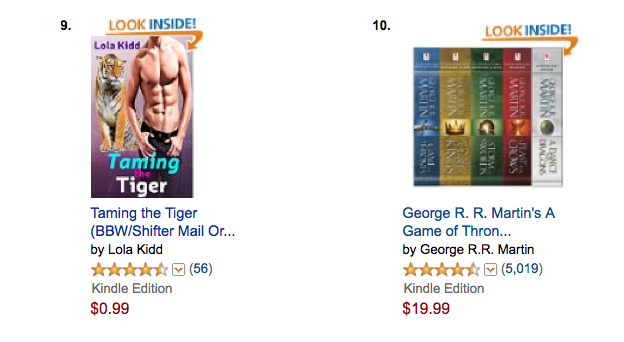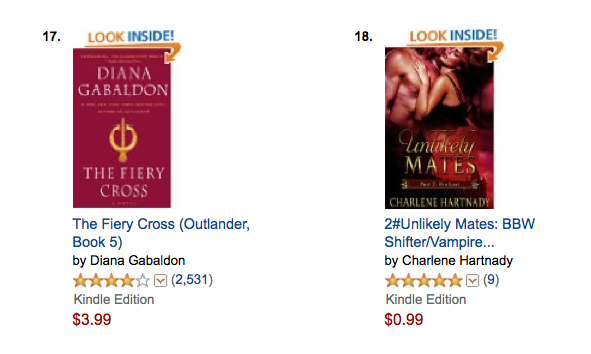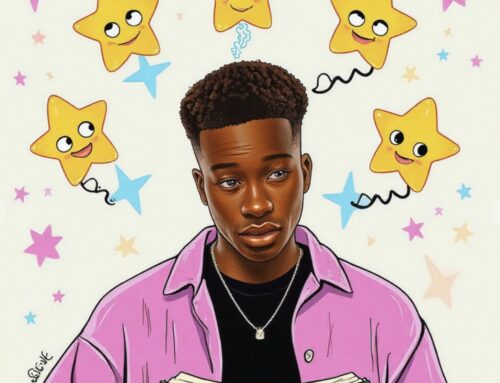I made a pretty shocking discovery on Amazon the other day.
Anyone, including your kid, can use the Look Inside feature, without logging in, to access books containing violent rape, incest, animal torture, pornographic scenes, erotica, terrorism, and murder.
Your kid doesn’t even need an account to read the first 10% of any book on Amazon. Here’s my (fictional) 9-year-old kid, looking at Amazon (not logged into an account), curiously typing in the word “porn”:

Now let’s see what happens if he or she clicks “Look Inside” – Oh, great! They can read the book! Not logged in, not trying to buy anything. So now my (fictional) 9-year-old can read (the first book that came up) “Lusty Mothers” (a perfectly fine book if you are over 18, of course) and learn what a MILF is!

I tried this with other words, and was able to glean many meanings, read scenarios including rape, organs being flashed, slashed and filled, animal murder, women being brutalized, and many other lovely subjects – and I could see photos in some cases.
Here’s the thing: Amazon has an opt-in age restriction policy on certain products for sale – not opt-out – that doesn’t include your self-published books. So is it your job as an author to age-restrict your readers, and how can you do that? Should you do that?
I have a disclaimer before you call me a prude.
I used to work in porn – well, sort of. I edited celebrity interviews, book reviews, reader’s letters, and product placement copy for Penthouse Magazine, 18 Up, and other such wonderful, erudite publications, for over two years, cutting my editorial teeth in a rather steep learning curve. Believe me, working in those offices as one of only three women, you have to be incredibly alright with a lot of things. Oh, the things I’ve seen…
But I was horrified when I moved to LA in 2013, the heart of pop movie culture, to learn that the MPAA allows entry to any kid under the restriction age, even with parents – or shockingly for me, any guardian over eighteen (so any kid with their older sibling or pal, then?) – Here’s the list of ratings explained. Because in the real world, watching kids watching really unsuitable content in real time from my theater seat disturbed me greatly. Going to the cinema to see the 2014 cannibal movie “Green Inferno” (Amazingly rated R, for aberrant violence and torture, grisly disturbing images, brief graphic nudity, sexual content, language and some drug use), that shows scenes of flesh-eating, being burned alive, and female circumcision (and gave my 42-year-old husband nightmares) two young parents, maybe bereft of a babysitter, had opted to take their under-five-year-old to the midnight movie with them, and that that was OK by US law. The kid was visibly upset and damaged by what was on the screen.
In fact, it’s only when a film receives an NC-17 rating (hardly ever awarded for obvious money-making reasons) that a child is not allowed into the movie theater in America.To put this in perspective, films as relatively tame as “Monster’s Ball,” “Scream” and “The Godfather III” have been awarded the NC-17 rating in the past, but not more modern films such as the ones mentioned above, giving a sense that as a culture we are desensitizing rapidly.
So why are books different?
Ironically, despite the MPAA’s weirdly liberal rating laws, Amazon gives parents a PIN lock for movies and TV shows at Amazon Instant Parental Controls. But not for books. Is this because books are less visceral? Is there a difference between words on a page and images on a screen? Is Amazon saying “Books move you less than movies”?
No. Amazon is actually passing the buck – and it’s a sensible, blanket standpoint. If you go to Amazon’s T+Cs for use of an account at: Privacy, Security & Accessibility > Conditions of Use, they state,
If you use this site, you are responsible for maintaining the confidentiality of your account and password and for restricting access to your computer, and you agree to accept responsibility for all activities that occur under your account or password. Amazon does sell products for children, but it sells them to adults, who can purchase with a credit card or other permitted payment method. ******** If you are under 18, you may use Amazon.com only with involvement of a parent or guardian. ***** Amazon reserves the right to refuse service, terminate accounts, remove or edit content, or cancel orders in their sole discretion.
There’s a lot of false equivalency on the Internet when discussing age restrictions for books. One person writes, “I read Cujo when I was eight, no damage done there!” Yes, but that wasn’t about a woman just like your mom having sex with random strangers, was it? I don’t think Stephen King has many scenes of S&M bordering on rape where the woman kind of enjoys it?
In a society that is kind of OK with their (sometimes pre) teenage daughters, “learning about sex and relationships by reading 50 Shades of Grey,” a book that is basically Twilight with handcuffs, whips, and a very nuanced messed-up relationship, are we really OK with this, or is there a zeitgeist that stops us from really thinking about what’s happening here? While 50 Shades is a fine, indulgently entertaining book when read the in context of a life of sexual experience and all the “shades” of perspective a grown woman has, it’s impossible for a child to have that same, literal, hands-on experience with emotion needed to parse this sort of fiction successfully as just that: fiction. Simply, kids shouldn’t be reading it, because they don’t have the tools to react to it. Let’s remember also that 50 Shades is now one of the more ‘tame’ crossover-style reads in this particular genre of “Mommy Porn” (Ugh, what a phrase).
So where do we draw the line?
These books service their clientele, and that’s just fine – but not all of us want to join in the party. So surely erotica and pornography needs its own adult section on Amazon as it has had in the real world forever? Surely that would be *great* for those kinds of authors, who could then funnel their readers to an X-rated section? After all, we don’t watch pornography at the family cinema, do we? But then maybe we’re going to see people railing for a ban on other accepted subjects if that happens. The right-wingers and the religious will cry out for books containing gay themes, swearing, drugs, and (normal, relationship-forming) sex to be locked down, too.
Amazon allows anyone to put any book in any category. If your book is science fiction erotica, it can be put in “Science Fiction.” So how then does Amazon rank the book on its Top 25 page? It sort of has to show it, if it’s ranking in that non-X-rated category. Today, “Taming The Tiger,” an erotic ‘Shifter’ book with a very loose fantasy connection, is up against “Game of Thrones” (OK, OK, GOT contains some pretty spectacular sex, but it’s bawdy, not pornographic):

Meanwhile, Diana Gabaldon, whose books I would consider suitable for a YA audience, is wrestling her position with “The Fiery Cross: Outlander” with “Unlikely Mates,” again, loosely themed to fit the category, and entirely unsuitable for any teen boy of say, 13, wanting to purchase “The Fiery Cross” – a book that is not really suitable to be in the “Kids” section:

So is this fair to anyone?
It’s going to now be impossible for me to send my teenage kid to browse Sci-Fi or Fantasy books at Amazon without forcing them to look at Kid’s Books only (oh, wait, kids can only look at Amazon with me – see Amazon policy).
Meanwhile, erotica is soaking up all possible categories simply by adding them in order to rank higher in more categories. So it’s also not fair on another level – most people aren’t looking for this sort of book when they go to “Science Fiction” or “Fantasy.”
It’s basically impossible for us as authors to age-rate our own books on Amazon. There’s no guide to do so, beyond not choosing an age range in the back end of Amazon. There, all we can do is tell Amazon it’s a kid’s book or an adult book. We can mention the “not suitable for…” in our book blurb. We can add trigger warnings such as “contains violent scenes of torture.” But that’s not really taking responsibility, is it?
My biggest, most overwhelming fear for self-publishers is that this lack of responsibility so greedily exercised by these charting authors might drive a new category on Amazon: SELF-PUBLISHED BOOKS. If authors can’t take responsibility for their own books and categorize them properly, Amazon might just have to bow to the trad publishers and cut them out completely of their main revenue source.
There are already those publishing houses who are taking their books off of Amazon for that exact reason – Amazon will reach a breaking point if certain larger publishers remove books. Ghettoizing self-published works would probably mean the death of self-publishing, for reasons we, as indie authors, don’t want to think about, do we? After all, there is still only a tiny percentage of self-publishers making money from Amazon in any big way, and the hard-hitters could probably work something out with smaller publishers if this came to pass. That would leave those who sell a reasonable amount, as a second income, or for pin money, in the cold.
Responsibility needs to happen fast.
We can start by being responsible with our categories. Adding erotica to the “Erotica” or “Romance” category only is the one fair way of selling your erotic book without dirtying the rest of Amazon up for the rest of us. Adding keywords such as “murder, torture, violence” can at least show some respect for our readers – and fellow authors.
We could at least start by taking a little responsibility ourselves for our Look Inside content if we write porn, murder, or erotica. We could make sure that the first 10% of our book is universally acceptable by adding blank pages, epigrams or an index.
Because admittedly, while most kids will find it highly amusing to read these kinds of things, there’s going to be those who remain damaged by it, and if there is any chance I am going to hurt a kid with my words, no amount of pride over my book is coming first in that scenario.
What do you think? Comments below.
Get an Editorial Review | Get Amazon Sales & Reviews | Get Edited | Get Beta Readers | Enter the SPR Book Awards | Other Marketing Services






















You might want to compare Amazon’s policy to Apple’s. I don’t let Apple off lightly either. I just made a posting trashing their fake (and lucrative) environmentalism. But Apple does force those submitting ebooks to pass through some checks. (My own hunch is that Steve Jobs’ wife is partially responsible for that.) Amazon doesn’t seem to care. All it cares about is market dominance.
Keep in mind that you’re probably not seeing the full extent of what Amazon sells. When I lived in Seattle, I knew a Google software developer who told me that she had friends at Amazon tasked with coming up with ways to hide from the general public the really trashy ebooks that Amazon sells. What outrages you isn’t even the worst that’s on Amazon’s virtual shelves.
“When I lived in Seattle, I knew a Google software developer who told me
that she had friends at Amazon tasked with coming up with ways to hide
from the general public the really trashy ebooks that Amazon sells.” WOW – we need to know more about this! So people may be self-publishing – and then they won’t be found ever!
You make some interesting points here and I too find it odd that it’s legal and acceptable in today’s society for theaters to admit children to R-rated movies so long as they are accompanied by a parent or guardian, whereas restrictions on admitting children are enforced by theaters playing movies with an NC-17 rating.
I think it’s a case of our society’s perception of a thing (R-Rated gets people’s attention enough without bothering them too much while NC-17 makes people think of porn so movies with the latter rating are avoided like the plague because of the general consensus that porn is something you don’t watch/consume in the company of others) versus the reality of a thing (explicit language, violence, etc. is inappropriate for underage children regardless of the rating/grade) has everyone’s head so far up their own behinds that too few people notice that something is wrong. Blood, guts and gore is ok. Shootings, stabbings, and other violent acts are ok. Semi-nudity and suggestive adult situations are ok. Explicit language is ok. It’s all ok….just so long as it isn’t (labeled as) porn because then that would be a cause for concern. If that isn’t some backwards logic, I don’t know what is.
So yeah I understand what you’re talking about. This is the situation we’re dealing with today and it is very sad.